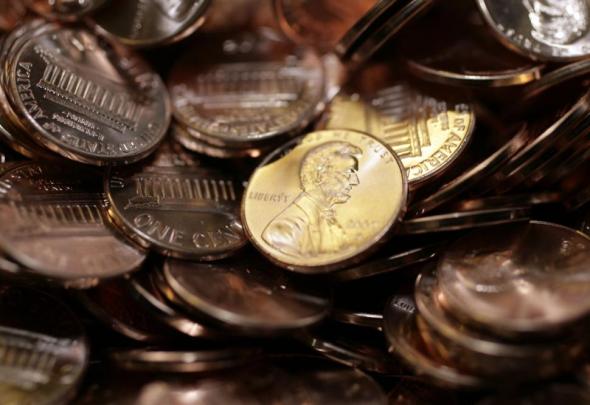A penny costs almost twice its value to make
Daily News Article — Posted on December 16, 2014
 (by Jeffrey Sparshott, The Wall Street Journal) – The U.S. Mint cut the cost of making the penny by nearly a third over the past two years, but the…copper-coated coin still costs more than a cent to produce.
(by Jeffrey Sparshott, The Wall Street Journal) – The U.S. Mint cut the cost of making the penny by nearly a third over the past two years, but the…copper-coated coin still costs more than a cent to produce.
A new report shows the cost to produce a penny was 1.7 cents in the 2014 fiscal year. That’s down from 2.4 cents in 2011 but still more than face value.
And that won’t change.
“There are no alternative metal compositions that reduce the manufacturing unit cost of the penny below its face value,” the U.S. Mint’s 2014 Biennial Report to Congress said.
The nickel, too, is dead weight for taxpayers. Production costs stood at 8 cents last year, down from 11 cents. The lower cost per coin is largely a result of rising production and reduced metal costs.
Other coins turn a profit. A dime costs 3.9 cents to make, and a quarter 9 cents. All together, the Mint made $289.1 million on seigniorage–the difference between the value of the coin and the cost to make it–despite a $90.5 million drag from the penny and nickel.
Congress in 2010 told the Mint to examine ways to save money on coin production, a mandate that so far has led to detailed testing of alternative metals and production methods, including the use of a laser to produce coin blanks.
The Mint estimates that switching up the metallic content of coins could save taxpayers $5 million to $57 million a year, though vending, amusement, laundry and other groups with coin operated machines warn that it could cost them billions to reconfigure machinery and make other adjustments needed to accept altered [coins], the Mint said.
“At this juncture, there are several possible options to alter the metallic compositions that would lower the costs of United States coins, but the Mint does not recommend adopting any of these options until ongoing research is completed on a promising alternative that has the potential to duplicate the weight and [electromagnetic signature] of existing coinage,” the Mint said.
Of course, the Mint could save $52.9 million if it simply eliminated the penny. That’s what Canada, the United Kingdom and other countries have done.
A Mint spokesman said he would let the report to Congress speak for itself.
Aside from noting that the penny can’t be produced for less than a cent, the report is silent on the topic.
Copyright 2014 Dow Jones & Company, Inc. All Rights Reserved. Reprinted here for educational purposes only. May not be reproduced on other websites without permission from The Wall Street Journal. Visit the website at wsj .com.
Questions
An easy way to help StudentNewsDaily is by making your Amazon purchases through Amazon’s smile.Amazon.com link. The AmazonSmile Foundation will donate 0.5% of the purchase price from all eligible AmazonSmile purchases to Student News Daily. Thank you!
1. a) How has the cost to make a penny changed in the last few years?
b) Why can’t the U.S. Mint reduce the cost to make the penny to below face value?
2. How is the government still making money on coin production if it costs more than the value to make pennies and nickels? Be specific.
3. a) What order did Congress give the Mint in 2010?
b) What options has the Mint considered to further comply with Congress?
4. Why are some groups opposed to the idea of changing the metallic content of coins - who are these groups)?
5. Why doesn’t the Mint recommend adopting any of the options available to save money on penny production at this time?
6. a) How have other countries saved money on penny production?
b) What do you think of this idea for the U.S.?
c) Ask a parent and also a grandparent the same question.
Background
Watch a related report:
